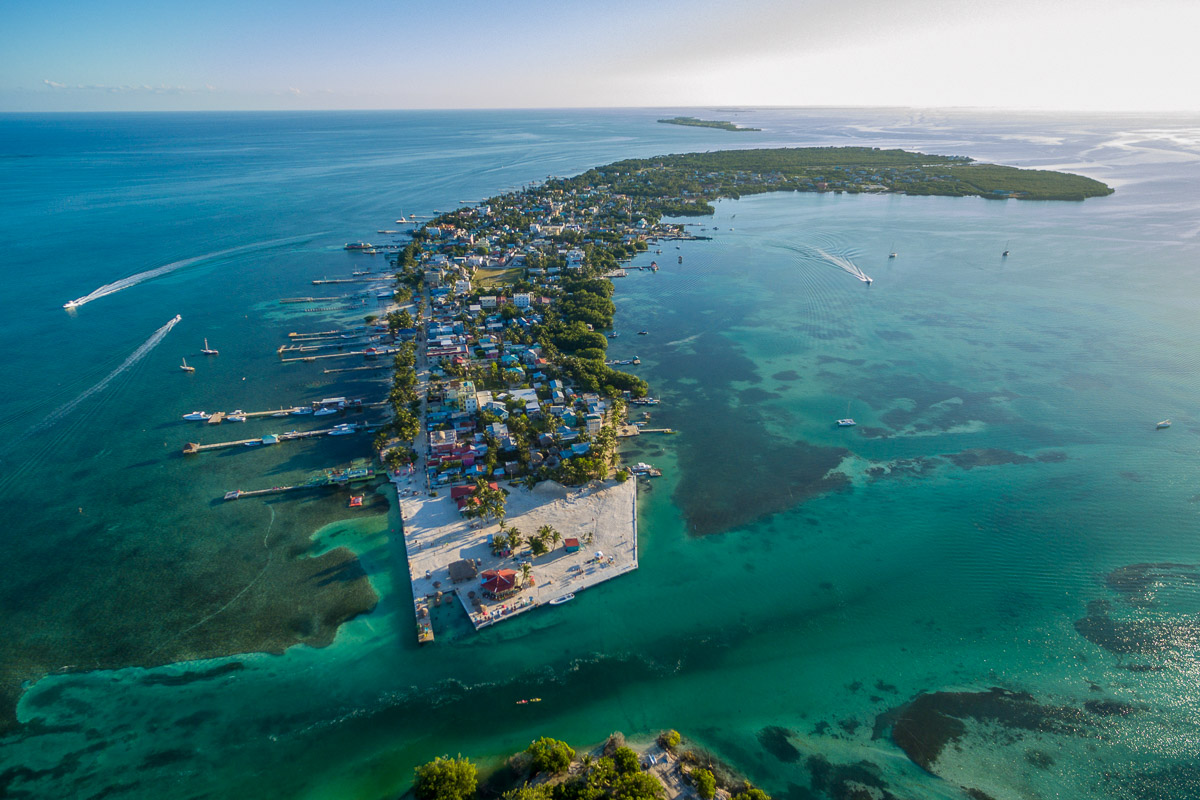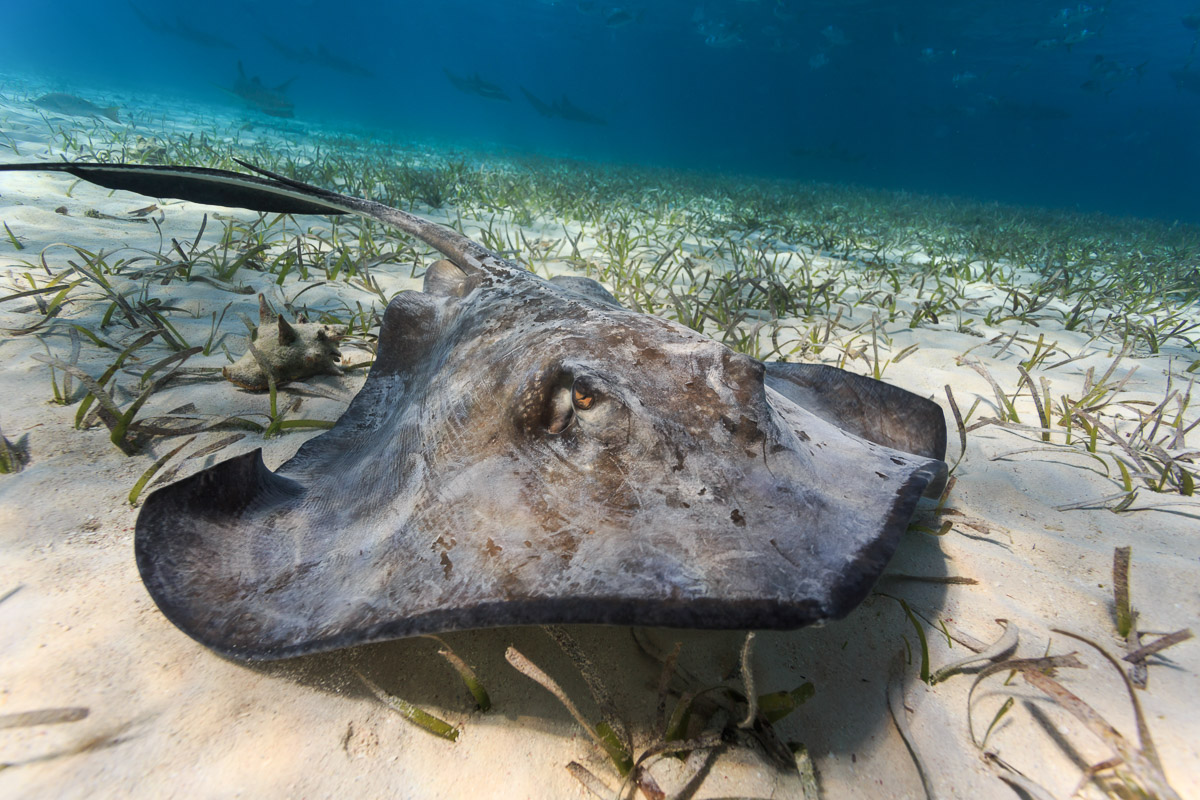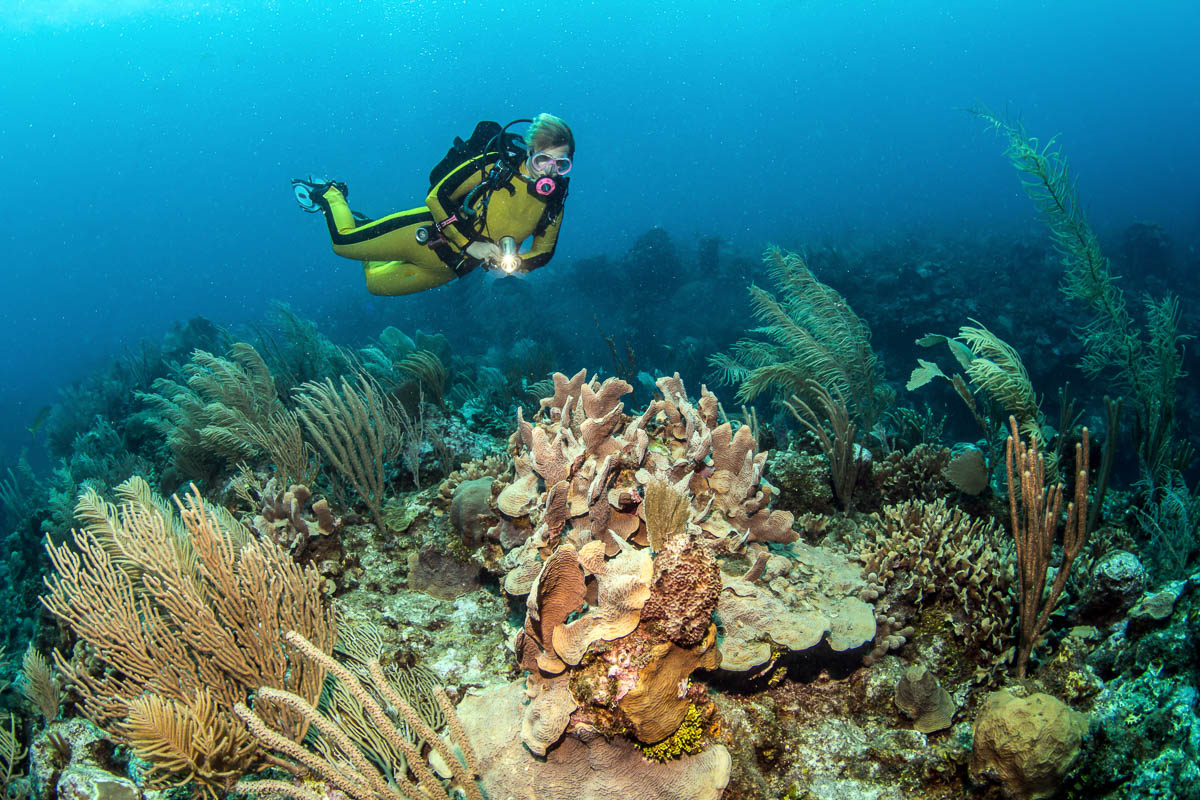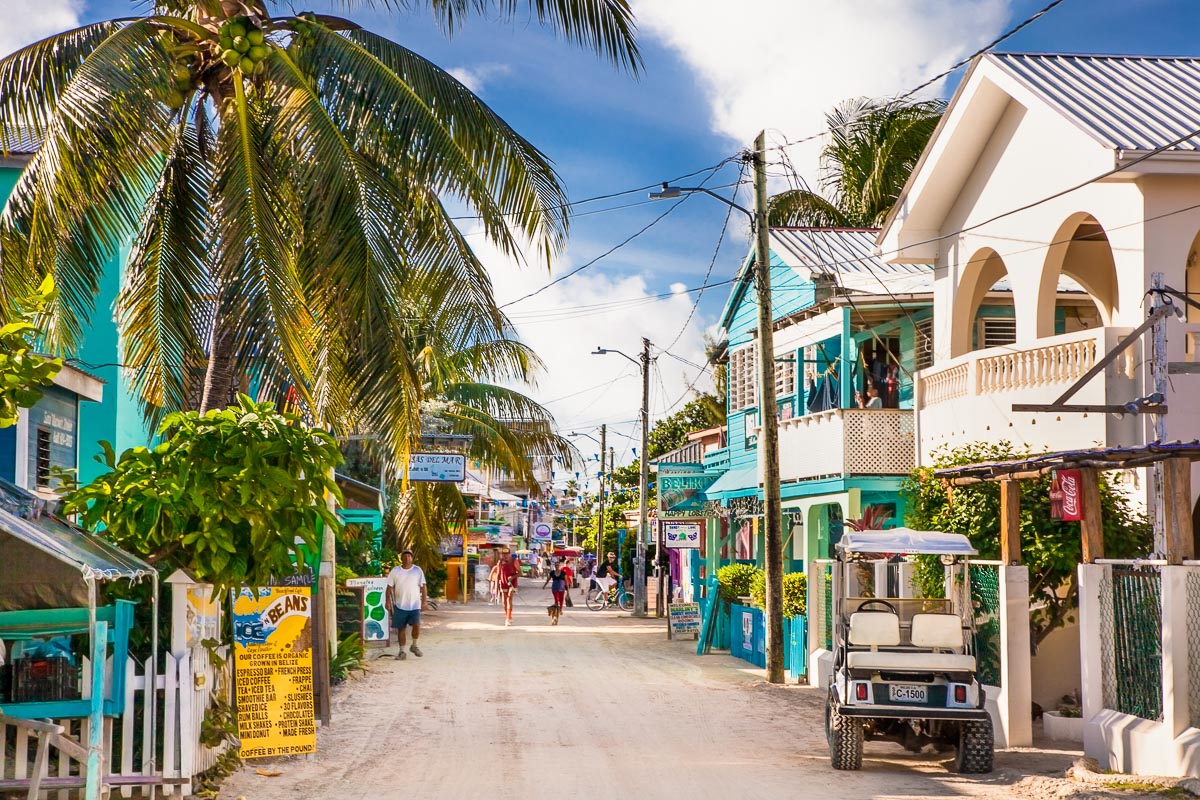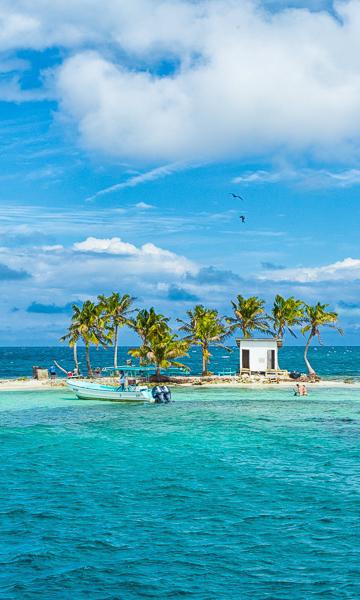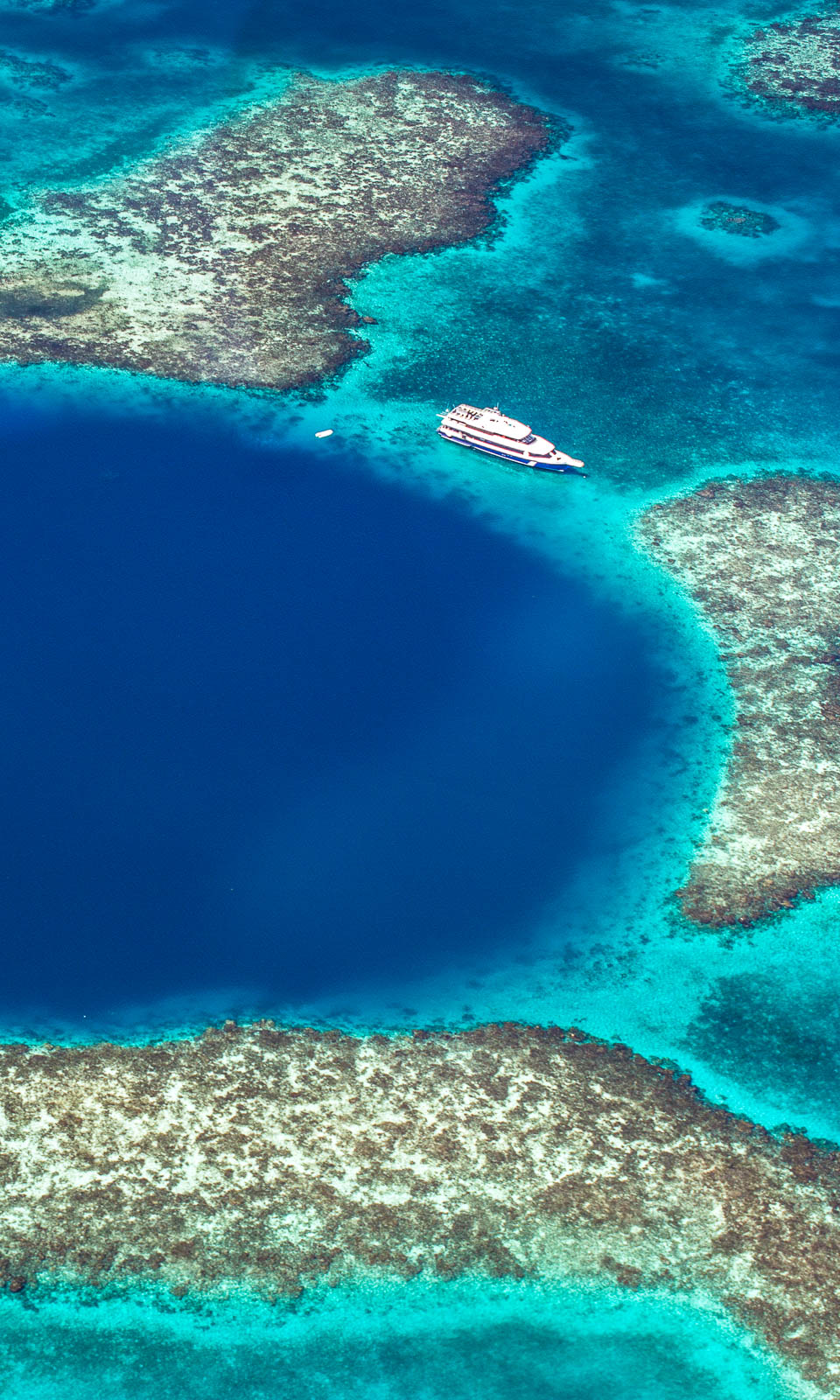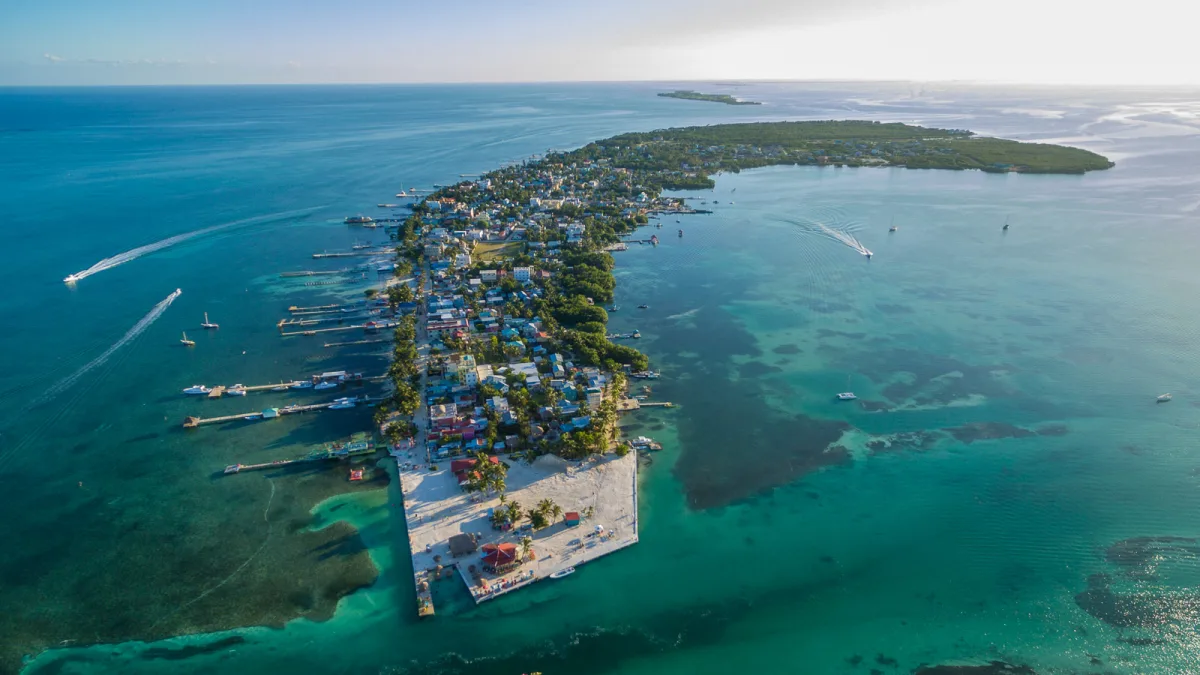
Scuba diving in
Ambergris Caye, San Pedro and Caye CaulkerHighlights
- Easy access to the Mesoamerican Barrier Reef for diving and snorkeling
- The beating-heart of Belize’s island tourism, and an epic tried-and-tested trip
- Explore nature reserves, national parks and UNESCO World Heritage sites
- Dive and snorkel with stingrays, turtles, nurse sharks, and much more
- Catch and release fishing for Belize’s ‘Big Three’ - bonefish, tarpon and permit
With their beautiful coastlines, crystal-clear water, and laid-back locals, Caye Caulker and Ambergris Caye have everything you could ask for from a Caribbean island getaway. Explore national parks, chill at ramshackle waterfront eateries, or try your hand at almost any water sport you can imagine, from flyfishing to scuba. With the Mesoamerican Barrier Reef on their doorstep, the islands offer easy access to the region’s spectacular coral and dramatic walls, with rays and sharks to boot. But with so much to do, don’t forget what this destination is all about - going slow and taking it easy!
Scuba diving in Ambergris Caye and Caye Caulker
- SharksYear round
- Eagle rayYear round
- StingraysYear round
- TurtlesYear round
- Schooling reef fishYear round
- Plentiful reef lifeYear round
Like much of Belize’s barrier reef diving, you can expect classic spur-and-groove formations on the exposed side of the reef, with beautiful formations to explore and sponge-scattered coral gardens. The inner side of the reef is sheltered and shallow, while the outer side descends, plateau by plateau, into the depths of the Caribbean Sea. Here, the combination of deeper water and faster-flowing currents means pelagic fish are the main attraction, with sharks, rays and other species all on the cards.
Ambergris Caye diving
Hol Chan, at Ambergris Caye’s southern tip, was the first area in Belize to be designated as a reserve and is one of the region’s most popular dive spots. The reserve includes barrier reef, seagrass flats, and mangrove areas, and is home to tarpons, grunts, and snapper. Experienced divers can fin out to the drop-off where spotted eagle rays and schools of barracuda can often be seen.
Just south of the Hol Chan Marine Reserve, a site known as Shark Ray Alley has become a hotspot for Southern stingrays and nurse sharks, drawn to the area by fishermen that clean their catch. Other fish attracted to the food include horse-eye jacks, silver porgy, blue runners, and Caribbean Ballyhoo. Here, snorkellers can swim amongst dozens of these docile stingrays and slow-moving sharks in crystal-clear water as they gather in anticipation of an easy meal.
Mexico Tunnel is another famous site, featuring a 40-metre long ‘tunnel’ between two spurs in the reef. Despite the name, this tunnel is really more of a gully, providing a great experience for beginner divers, as well as those with more experience. Longspine squirrelfish, hogfish, tiger grouper, foureye butterflyfish, and blue tangs can all be seen here. For wide-angle photography, Tackle Box Canyons near San Pedro is hard to beat with dark caverns, tunnels and walls contrasting with the clear, coral-filled waters above.
Caye Caulker diving
Around Caye Caulker you can find more canyon-like coral formations at sites such as Rock Beauty, Island Queen Canyons, and Raggedy Anne. Divers based on the island can also dive Ambergris Caye just 25-kilometres to the north, and many dive centres will also offer extended day trips to famous sites such as Turneffe Atoll, Lighthouse Reef and the Great Blue Hole.
Diving Environment
Sharks, rays, canyons and reefs
Beginner upwards
Year round
5 - 40m
15 - 30m
25 - 29C
Top tips
- Thimble jellyfish spawn during May, and can be irritating to scuba divers and snorkelers. Consider using a full-length wetsuit to avoid getting stung.
- During peak season, when planes servicing the islands are full, your luggage can occasionally arrive on the following flight.
- If you’re booking an onward flight from Belize City to the islands, leave plenty of time between arrival and departure to allow for delays or consider an overnight stay.
- Travelling with kids? Check out San Pedro’s beachfront Boca del Rio Park - it has a playground, swings, sports courts, and waterslides into the shallow part of the bay.
- English, Spanish, and the English-based Belizean Creole are all widely spoken, making communication simple and charmingly creative.
About Ambergris Caye and Caye Caulker
Ambergris Caye and Caye Caulker are the beating heart of Belize’s island tourism. Despite a difference in size and unique atmospheres on each island, they share a reputation as two of the most vibrant and welcoming islands imaginable, thanks to an eclectic collection of cultures - from Mexican Mestizos and indigenous Maya to Caribbean and Creole, as well as obvious European and North American influences. And, as you can imagine, you’ll find a wide range of architecture here, from ancient Mayan structures to funky-coloured Caribbean cabanas and luxury lodges.
The impressive Mesoamerican Barrier Reef lies closest to the mainland in the north of Belize, located just one-kilometre from shore in some places. For obvious reasons, this is where some of the country’s best and most accessible diving can be found, making it a great base for visiting divers. You’ll have kilometres of barrier reef to explore, and much more just a little further afield. And, with plenty of protection from the reef itself, many dive sites are as easy-going as the destination itself.
How to get there
Getting to Ambergris Caye and Caye Caulker couldn’t be easier. International flights land at the Philip S. W. Goldson Airport in Belize City, from where you can take a taxi to the ferry station. From Belize City, the ferry takes 45-minutes to Caye Caulker, and a further 45-minutes to reach Ambergris Caye. Flights also leave regularly from both the international and domestic airports, taking just 15-minutes or so to reach either island.
There are few cars on Ambergris Caye, and none on Caye Caulker, but getting around is simple. On the larger of the two islands, Ambergris Caye, you’ll find plenty of scooters for hire as well as golf carts to taxi you from place to place. On Caye Caulker, motorised transport is reduced to golf carts, but with an island this small, you can easily get by with a pedal bike or on foot.
Where to stay
The largest island in Belize, Ambergris Caye is a bustling tourist destination with a fun and laid-back atmosphere. San Pedro is the island’s only town and features a lively ambience with an array of beach bars and expat-owned establishments. High-season sees San Pedro’s narrow streets packed with golf carts and pedestrians, but true to Belize’s style of slow-living, the atmosphere is always relaxed. A new road connecting downtown San Pedro with the island’s north has paved the way for increased development, but for now, the north still offers fewer crowds and more tropical scenery. South of San Pedro, you’ll find a lovely mix of local and North American cultures.
Accommodation is easy to come by throughout the island, with everything from budget backpacker rooms and welcoming guesthouses, to lavish villas and all-inclusive resorts.
Just eight-kilometres long and less than two-kilometres wide, Caye Caulker is Ambergris’ smaller, less-developed cousin. A regular stop on the Central American backpacker circuit, Caye Caulker is well-known for its laid-back beach party vibe - with cheap beer, good rum, and great food. Despite having fewer beaches than Ambergris, Caye Caulker still offers an ocean-front social scene that revolves around the many piers and docks. And there’s no shortage of accommodation either. Expect hip backpacker hostels and boutique beach hotels with a vibrant Caribbean charm.
If you’re after a little extra dose of ultra luxury, then you might consider a stay on Caye Chapel to the south. This exclusive island, fringed by beautiful golden beaches is the site of the new Four Seasons resort - and it even has a golf course and airtstrip!
Dive seasons and weather
You can dive Ambergris Caye and Caye Caulker year-round, but there are some seasonal variations worth considering. June through November is the wet season which brings light wind, surface chop, and intermittent rain, as well as the possibility of tropical storms. In the unfortunate event that a storm hits, diving will likely be suspended for a few days. August through October generally sees the most rain, which can reduce visibility, especially in the shallows. The dry season runs from December through May when the weather is mostly warm and sunny. Water temperatures fluctuate just a few degrees throughout the year, hitting lows of around 26°C in February and highs of around 29°C in September.
May is the best month to spot mating sea turtles, while August is the peak time to see the females laying eggs on the beach. After spending a couple of months beneath the sand, the hatchlings tend to emerge around October. A variety of groupers can also be seen schooling en-mass to mate during full moons between October and November.
Conservation
Ambergris Caye is home to the Bacalar Chico National Park in the north which is composed of a 15,000-acre marine reserve and a 12,000-acre terrestrial reserve, and has been named an UNESCO World Heritage site. In the south, is the Marco Gonzalez Archaeological Reserve, a collection of some 49 known structures believed to have been used by the Mayans as a trading post. And, at the southern tip of the island, is the Hol Chan Marine Reserve which incorporates the barrier reef, seagrass beds and the mangrove islands of Boca Chica and Cangrejo Shoals.
The government has also imposed a moratorium on oil exploration and drilling in all of Belize’s offshore waters. In 2018, thanks to the Belizean Government’s clear commitment to conservation, UNESCO removed the Belize Barrier Reef Reserve System from its list of World Heritage in Danger sites.
